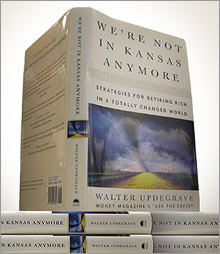|
|

|
|
More information on Updegrave's new book.
|
|
|
|
|
|
|
NEW YORK (CNN/Money) -
I retired about two years ago and left my 401(k), which is about 90 percent invested in a capital preservation fund, with my previous employer. I'd like to start drawing about $50,000 a year from it to supplement my income, but am wondering how to go about it. What do you say?
-- Al Jinete, Farmingdale, New York
Let me start with a question of my own: Why in the world have you left your 401(k) with your previous employer if you're retired? I suppose that could make sense if your old 401(k) plan has fantastic low-cost investment options that aren't available anywhere else. But I doubt that's the case.
So the first thing I think you ought to consider is rolling over your 401(k) into an IRA Rollover account where you should have easier access to your money and, most likely, a broader array of investing options.
Once you roll over your 401(k) dough, the next thing I think you ought to consider is building a portfolio that has a little more growth potential. Unless you've got a whole lot of other money invested in stocks or you're pushing 90, having 90 percent of your money in a capital preservation fund -- essentially, an income producing investment that's even less volatile than most bond funds -- is playing it way too conservatively.
If you're going to be spending 20 or more years in retirement, you'll want to be sure that the amount you withdraw from your portfolio each year keeps pace with inflation. Otherwise, you won't be able to maintain your standard of living in retirement.
That means you'll probably need a higher return on your money than a capital preservation fund is likely to give you. And the best way to get that return is by including some stock funds in your retirement portfolio.
A little number-crunching first
Here's what I suggest you do. Go to the Retirement Income Calculator tool at the T. Rowe Price site. The tool will ask you for information such as your age, the size of your portfolio, the amount of time you expect to live in retirement and the amount you want to draw from your holdings each month. (The tool will automatically adjust your withdraw amount for inflation each year.)
In the pulldown menu that asks you to choose a portfolio, choose A, which is the most conservative option with just 5 percent stocks. Then hit the calculate button.
The tool will show you the odds that your portfolio will be able to generate the monthly draw you've specified for the entire length of your retirement given the likely returns your portfolio will generate.
If the odds of your portfolio giving you your 50 grand for the rest of your life are relatively high -- say, 80 percent or more -- then fine. Perhaps you can afford to invest very conservatively and still get the income you want from your portfolio.
Get a sense of your financial needs
I suspect, however, you'll find two things: first, that in order to boost your odds of success to a reasonable level, you will have to choose a portfolio that has more stocks. (You can do that by choosing one of the other portfolios on the pulldown menu and hitting the calculate button again.)
Second, I wouldn't be surprised if you find that you also have to scale back your withdrawals a bit in order to have a reasonable chance of your money lasting the rest of your life. I say this because most people tend to overestimate the amount of income they can draw from their portfolios in retirement.
Only by going through this exercise such as this can you get a decent sense of how much money you can pull from your portfolio during a long retirement -- and how you must invest your portfolio to reduce the chance of running out of money before you run out of time.
You may find that the portfolio that gives you the highest withdrawals for the longest time is one that requires you to hold more stocks than you're comfortable with. Fine, dial your stock holdings back. But realize that by accepting a more conservative portfolio, your returns will be lower, which means you'll either have to scale back the size of your withdrawals or accept a higher risk of running out of money.
That may not be a pleasant prospect. But it sure beats watching your portfolio's value dwindle to nothing in your later retirement years.
Walter Updegrave is a senior editor at MONEY Magazine and is the author of "We're Not in Kansas Anymore: Strategies for Retiring Rich in a Totally Changed World."

|